How to Disconnect iPhone from Mac?: Try These 11 Effective Ways
Apple’s cutting-edge features and its superior ecosystem effectively connect different Apple gadgets for seamless flow. For example, if you log in with the same Apple ID, your iPhone will be synced with your Mac. However, some of you may prefer to keep the laptop and phone separate. That is when you should understand how to disconnect iPhone from Mac.
In this article, we’re going to provide a detailed guide to 11 such helpful ways including Bluetooth, AirDrop, iCloud login, and others that can be used to disconnect your iPhone from a Mac.
- Remove Your Mac from Apple ID
- Turn Off Messages Sync on the Mac
- Disconnect the iPhone from the Mac’s Finder
- Stop Bluetooth Syncing on Mac and iPhone
- Disable Handoff on iPhone and Mac
- Stop iCloud Syncing
- Turn Off AirDrop
- Disconnect a Mac from Personal Hotspot
- Disconnect Incoming iPhone Calls on a Mac
- Turn Off the Continuity Camera
- Stop Syncing of iPhone Notes With Your Mac
- Final Words
- FAQs
Remove Your Mac from Apple ID
As we all know, signing in with the same Apple ID is required to sync and use iCloud across multiple Apple devices. So, if you want to unlink your iPhone from your Mac, the best possible solution is to sign out or remove the device from your Apple account.
Here is the simple process for how to disconnect your iPhone from your MacBook using your mobile device:
- First, on your iPhone go to Settings > Apple ID, iCloud, Media & Purchases, which is generally labeled as your name.
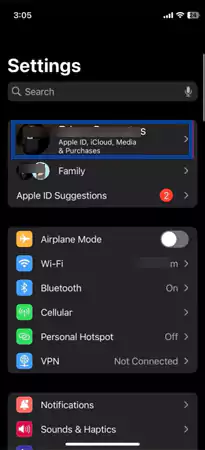
- Scroll down and find your Mac device from the list you want to remove from the ID.
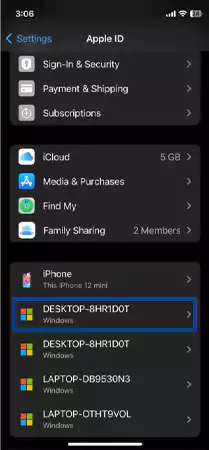
- Next, tap on the Remove from Account option.
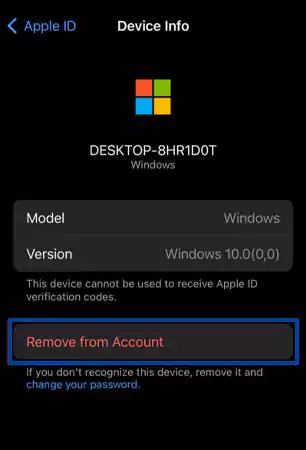
- Finally, it will ask you for confirmation, tap on Remove.
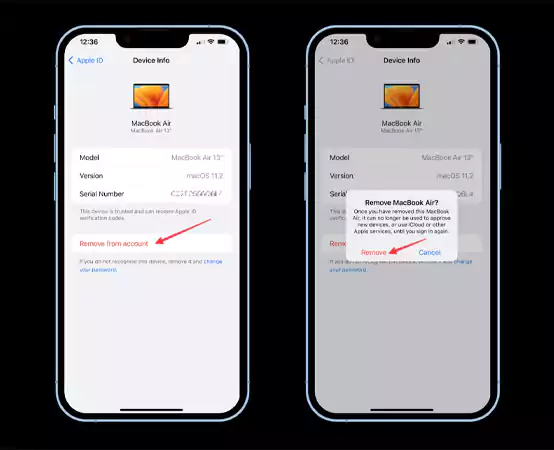
Note: To remove your iPhone from the Apple ID, go to the Apple ID settings page and select Sign Out.
You can also remove the Apple ID on your Mac as follows:
- Head to the Apple menu on your Mac > System Settings.
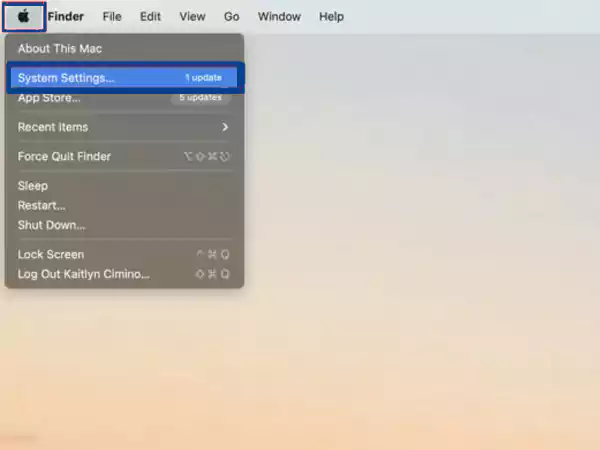
- Select the Apple ID > choose the device you want to unpair > click on Remove from Account.
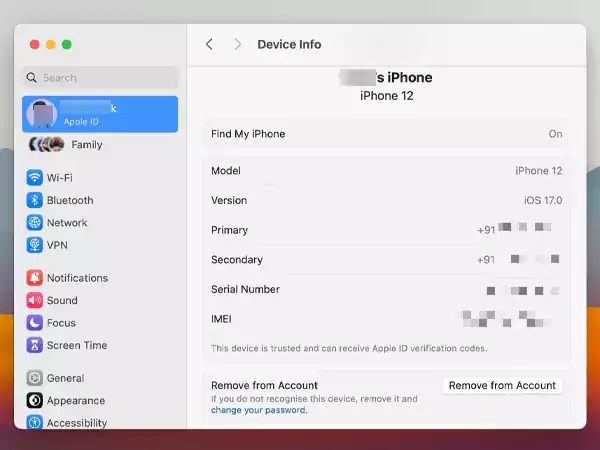
In case, you want to disconnect some particular features of the iPhone with your Mac, consider the methods discussed further.
Turn Off Messages Sync on the Mac
If you don’t want to see your iPhone messages on your Mac, you can turn them off via iPhone as follows:
- Go to Settings > Messages.
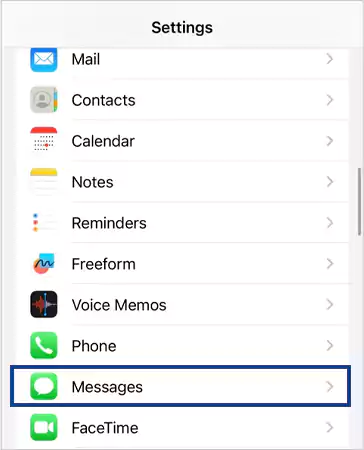
- Now, head to SMS Forwarding.
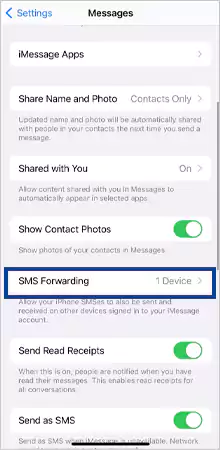
- Toggle off for your Mac device.
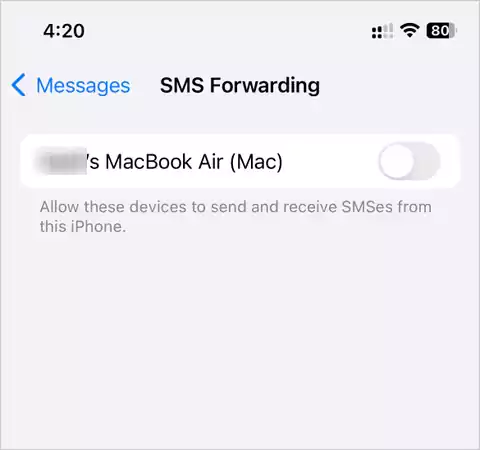
Alternatively, you can turn off sending and receiving messages via your Mac by completing the steps given below:
- Open the Messages app on your Mac from the Dock.
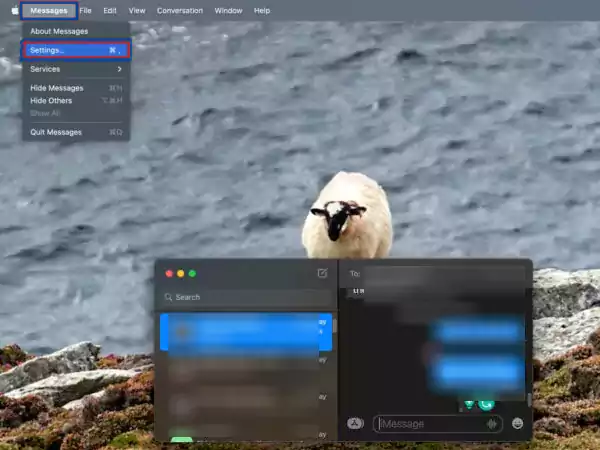
- Then, head to the Messages section from the top > select Settings.
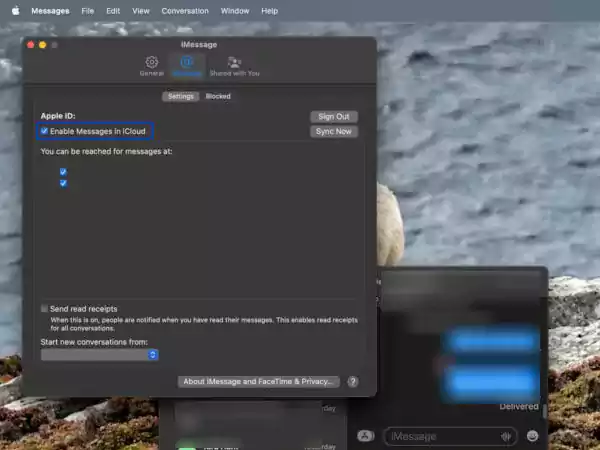
- After that, click on the iMessage tab.
- Now, uncheck the boxes next to Enable Messages in iCloud.
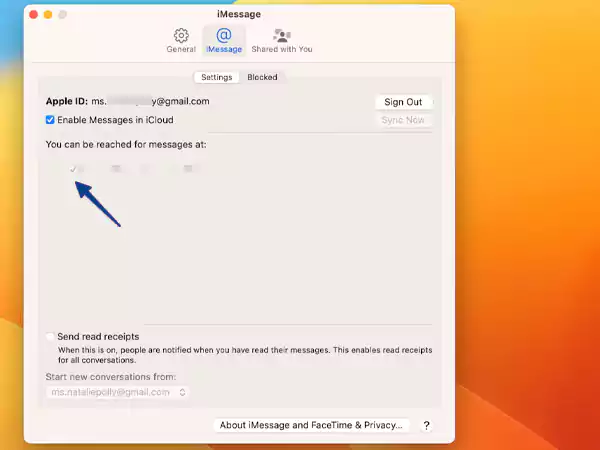
- Finally, hit the Disable This Device option for confirmation.
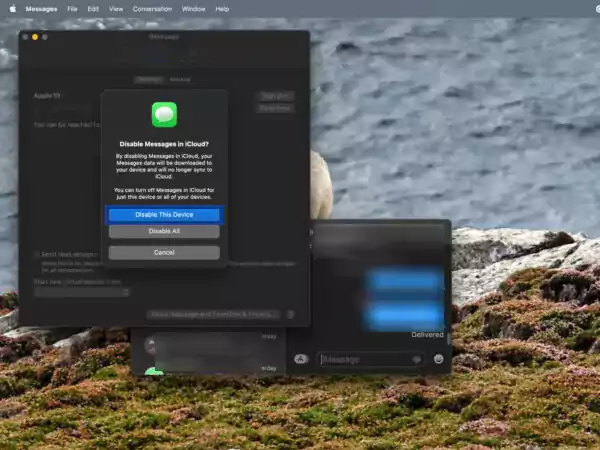
This way you can stop receiving both text and iMessage replies on your Mac and will be accessible through your iPhone only. Later, if you want to enable this feature again but are having trouble, consider our guide to how to sync messages from iPhone to Mac.
Disconnect the iPhone from the Mac’s Finder
You can simply unplug the USB cable if you don’t want to show your iPhone in the Finder on your Mac. But if you have set up Finder to find iOS devices over Wi-Fi, this method won’t work. In such a case, you can follow the given steps to unlink both devices:
- Visit Finder and select your iPhone from the sidebar.
- Then, scroll down and uncheck the box next to the ‘Show this iPhone when on Wi-Fi’ under the Options section.
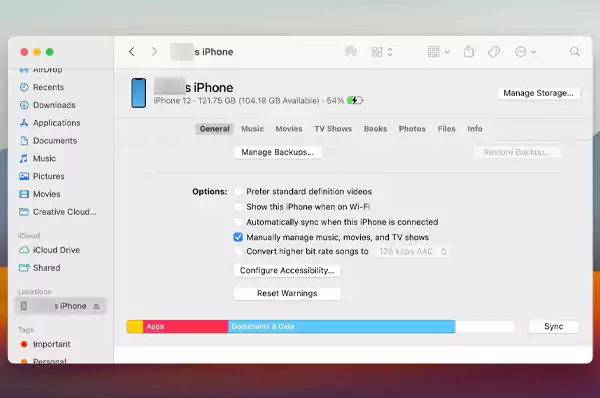
In case, you don’t own a Mac, you can head to iPhone’s Settings > General > Transfer or Reset iPhone > Reset > Reset Location & Privacy to reset the permission.
Stop Bluetooth Syncing on Mac and iPhone
If your iPhone and Mac are connected through Bluetooth, it is so easy to disconnect them. For this, you only have to complete the 4 simple steps:
- On your iPhone, head to Settings > Bluetooth.
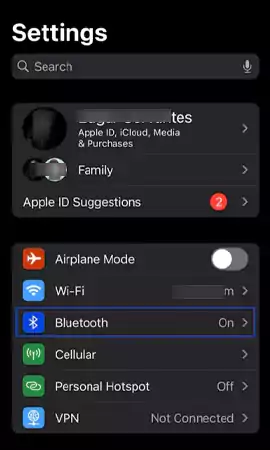
- Toggle to turn on the Bluetooth and from the list of available devices, locate your Mac and tap on the
icon next to the device’s name.
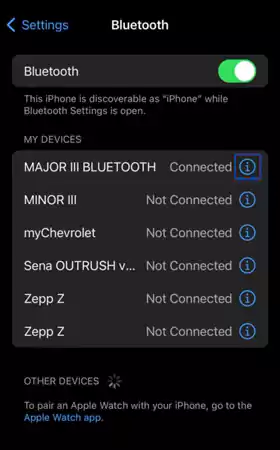
- Finally, tap on the Disconnect option.
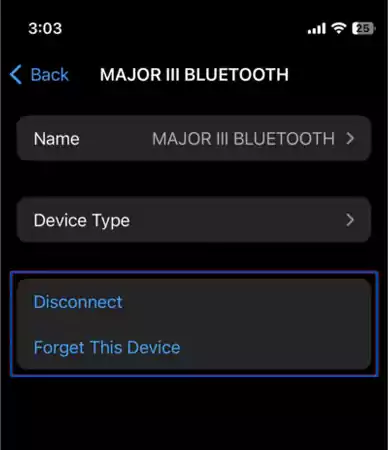
Note: If you want to completely unpair the device, select Forget This Device option.
On the other hand, to disconnect Bluetooth from a Mac, follow the given steps:
- Click on the Apple menu > System Settings.

- Now, select the Bluetooth option.
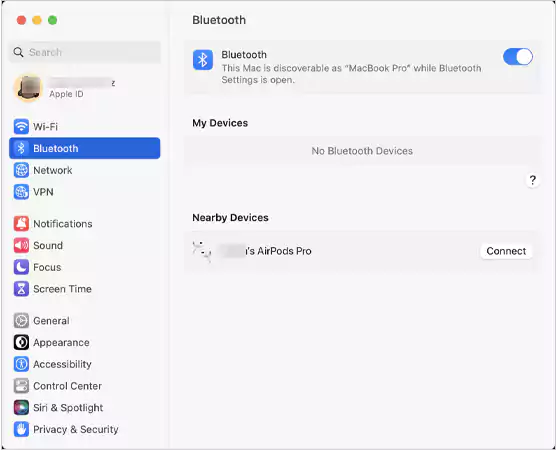
- Then, hover the pointer over the Bluetooth device and hit the Disconnect.
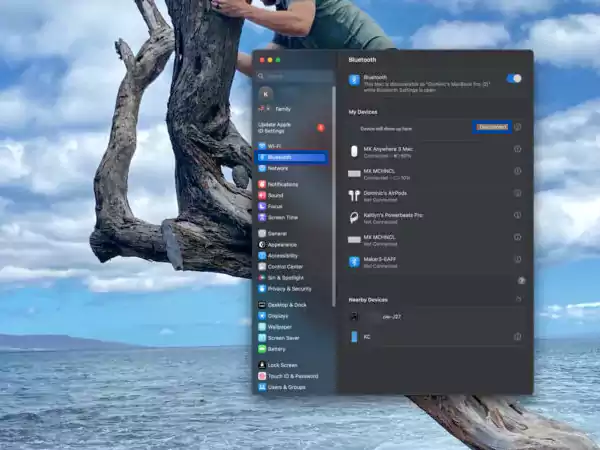
- If you want to remove the device, press Ctrl while you click on the Bluetooth device and select Forget.
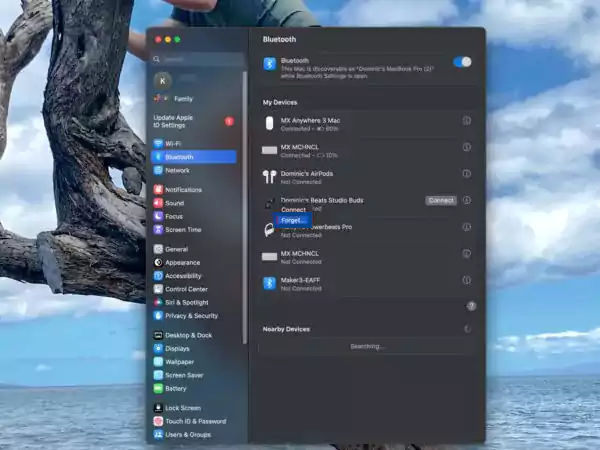
This will unpair your Mac and iPhone, and you will need to repeat the pairing process if you want to reconnect them later.
Disable Handoff on iPhone and Mac
The Handoff feature of Apple makes it easier to work with different devices, e.g., you can start a doc on your iPhone and then continue it on your Mac or iPad. However, this can be a bit annoying when you get constant cues on your dock. So, you can disconnect the syncing of handoff through your iPhone, by following the steps mentioned below:
- On your iPhone, launch the Settings app and head to General.
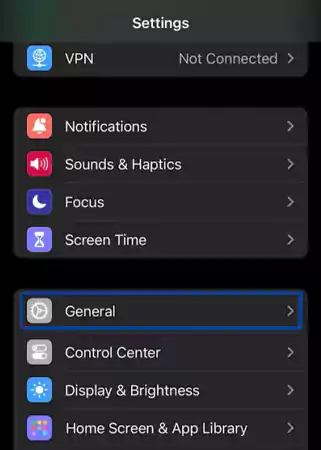
- Next, tap on the Airplay & Handoff.
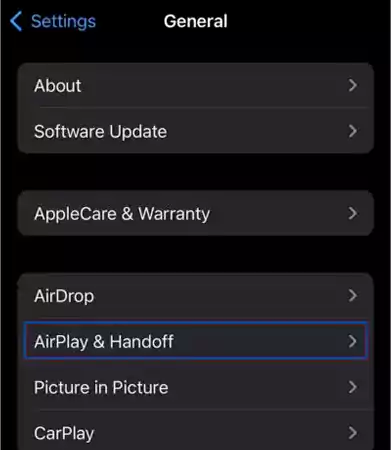
- Finally, toggle off Handoff.

You can also disable the Handoff on Mac through the following steps:
- Go to the Apple menu > System Settings.

- Head to the General > AirDrop & Handoff.
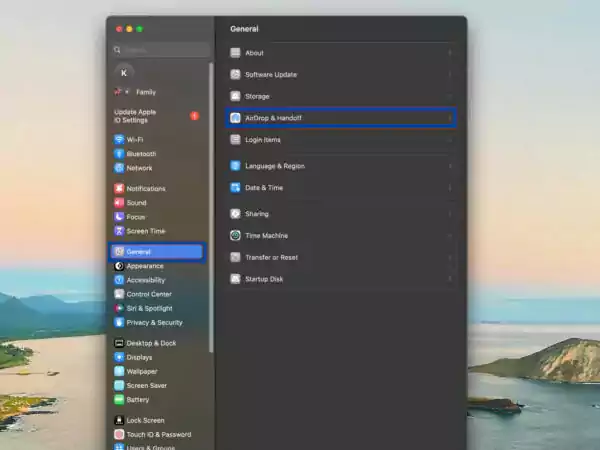
- Then, toggle off ‘Allow Handoff between this Mac and your iCloud devices’.
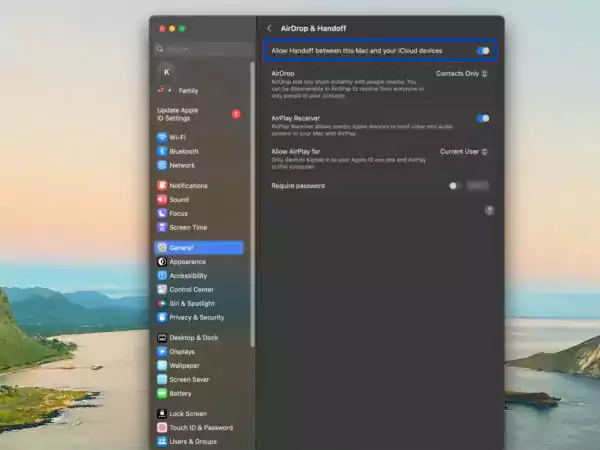
- Finally, click on the Don’t Allow Handoff to confirm.
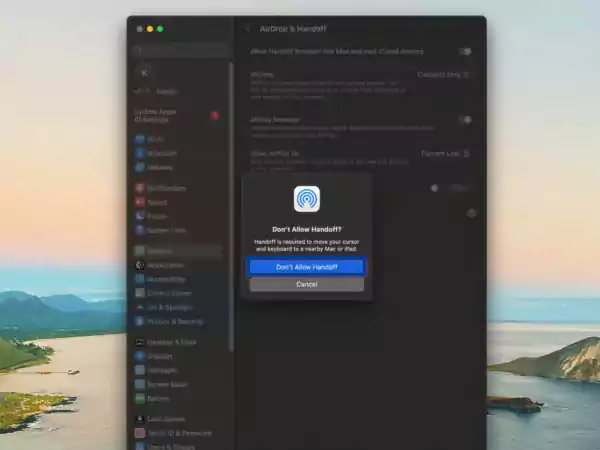
Also Read: 8 Amazing iPhone Tips to Keep Working at Peak Performance
Stop iCloud Syncing
If you want to stop the automatic syncing of images, contacts, calendars, and other features, you can easily avoid iCloud syncing through your iPhone as follows:
- Go to Settings > tap on your Apple ID.

- Head to the iCloud option.
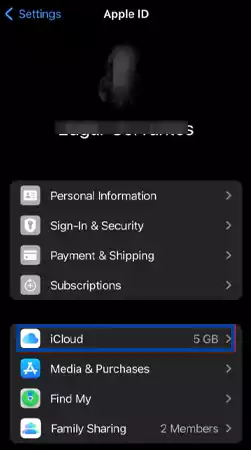
- Select Show All under Apps Using iCloud.
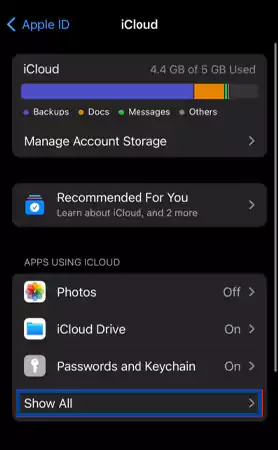
- Scroll down, and you’ll see a list of apps. Toggle off the required app.
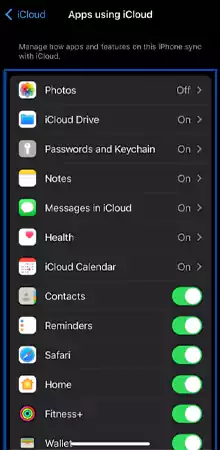
Similarly, you can stop iCloud syncing using your Mac as well. For this, follow these steps:
- Head to Apple menu > System Settings.

- Then, click on your Apple ID from the left sidebar and then select the iCloud option.
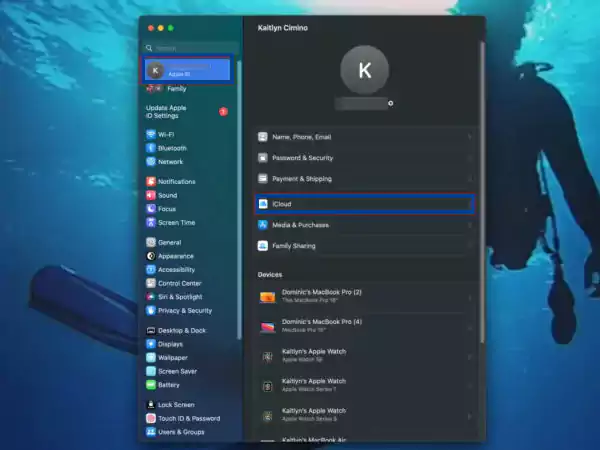
- Finally, toggle off services you don’t need.
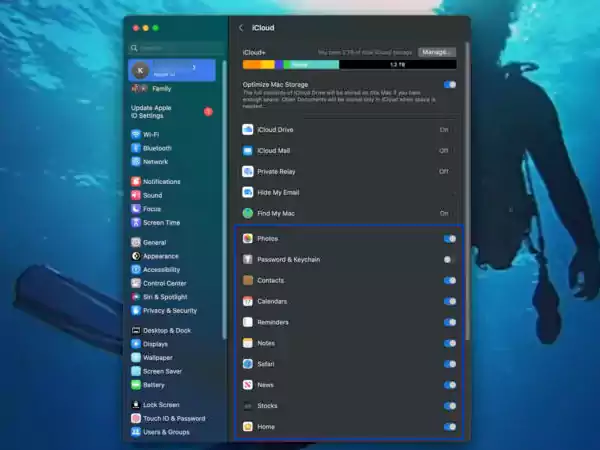
Several iCloud services that you can disable through this way include Photos, Contacts, Calendars, Reminder, etc. Some of them may ask you to download the data, so click on the Download button if you want to.
Turn Off AirDrop
AirDrop makes it easier to share and receive files within the Apple ecosystem. If you want to stop receiving files from your Mac, you can follow the given process through your iPhone:
- On your iPhone, head to the Settings > General.

- Now, tap on the AirDrop option.
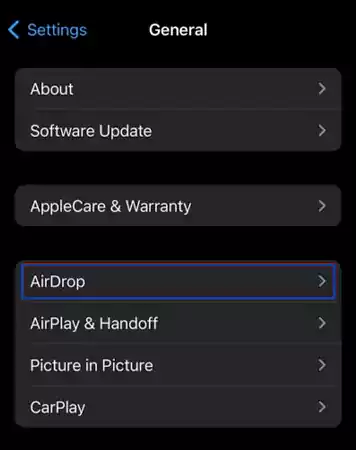
- Then, tap on Receiving Off.
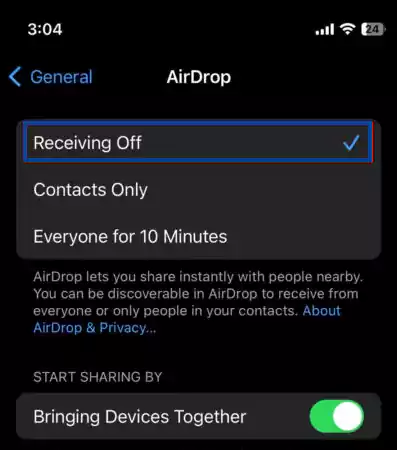
Note: Remember, this method will also stop the iPhone from receiving files from the devices via AirDrop.
Conversely, you can restrict your Mac from showing up in AirDrop on your iPhone as follows:
- Go to Apple menu > System Settings.

- Select General > AirDrop and Handoff.
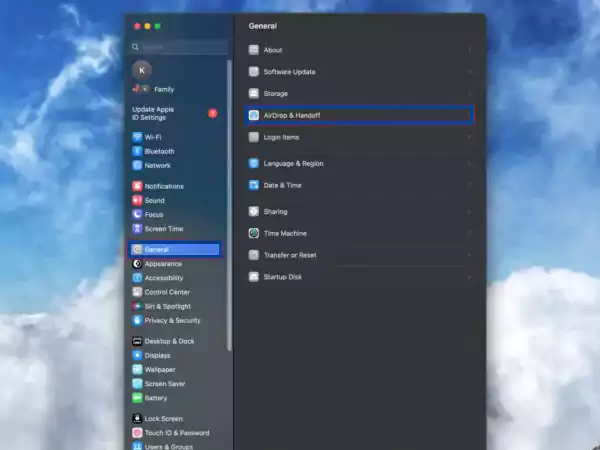
- Then, click on the AirDrop drop-down menu.

- Finally, set it to No One.
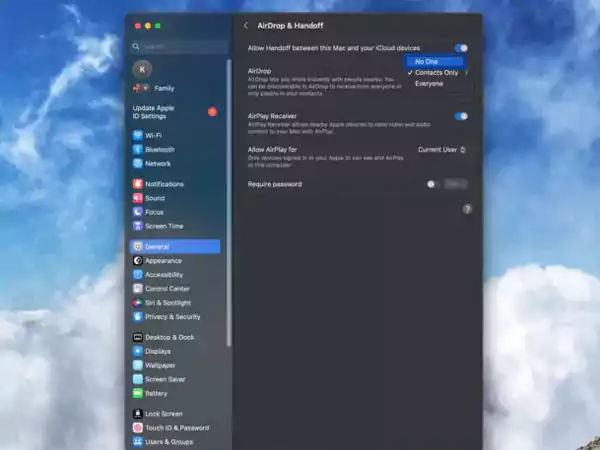
Note: AirDrop is sometimes considered to be a security risk as anyone from the Apple ecosystem can send you files that can also insert malware into your iPhone, iPad, or Mac.
Disconnect a Mac from Personal Hotspot
If you are using the Personal Hotspot of your iPhone for your Mac and want to disconnect it, you can simply turn off the hotspot. But this may restrict other devices as well from using the hotspot. In this case, you can particularly disconnect it for your Mac only, as follows:
- Click on Apple menu > System Settings.
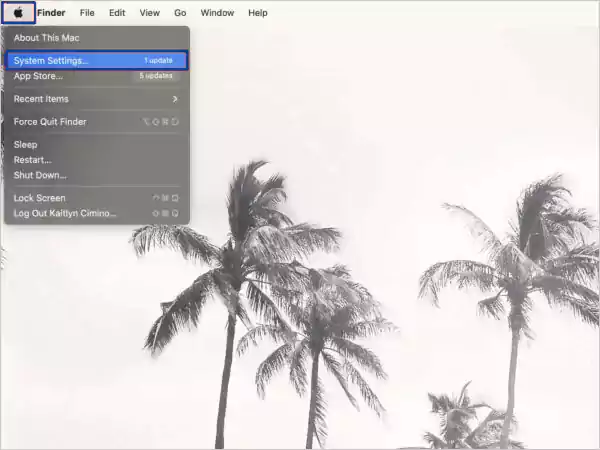
- Now, select the Wi-Fi option from the left sidebar.
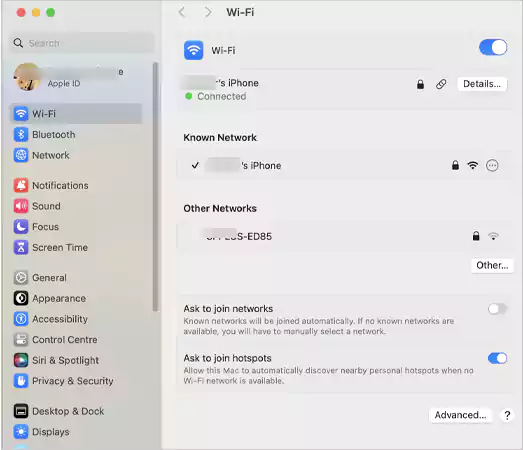
- Then, find the network, i.e., your iPhone, click on the details icon next to it, and select Forget This Network.
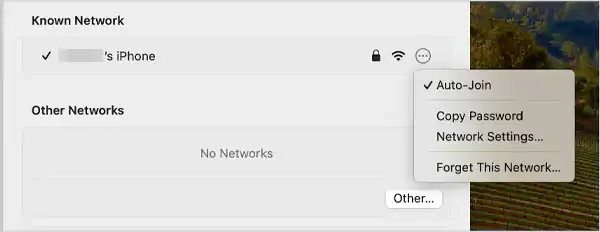
- Finally, confirm the process by hitting Remove.
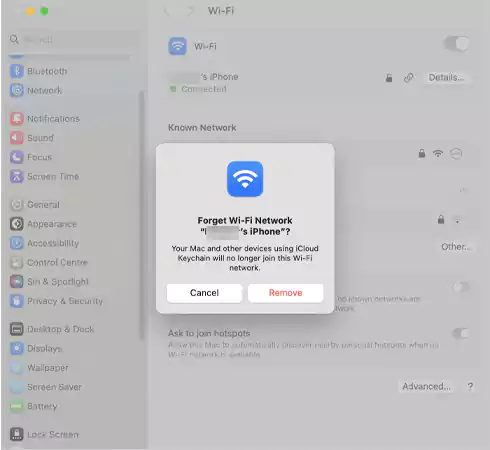
Apart from this, you can also restrict devices such as Mac, from joining your iPhone’s Personal Hotspot as follows:
- Go to Settings > Personal Hotspot.
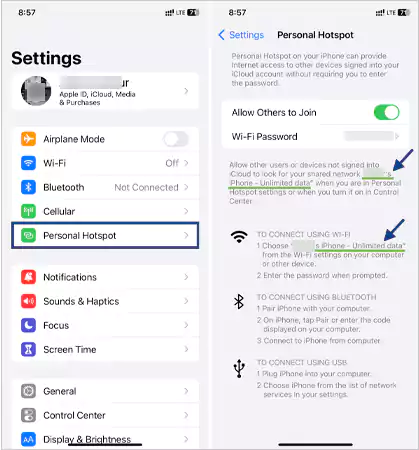
- Toggle off the option to Allow Others to Join.
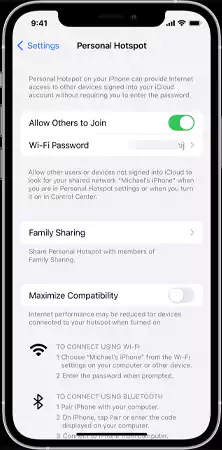
Alternatively, you can go to Control Center on your iPhone > long press on the Mobile Data icon > enable the ‘Personal Data is Not Discoverable’ option to turn it gray.
Also Read: Revolutionize Your Connectivity: Ultimate Guide to Hotspot Solutions for iPhone
Disconnect Incoming iPhone Calls on a Mac
Do you find it annoying that your Mac rings every time someone calls on your iPhone? You can simply disconnect the phone calls and FaceTime calls on your Mac through the given process:
- First, head to the FaceTime app from the Dock.
- Next, select FaceTime > Settings.

- At last, uncheck ‘Calls From iPhone’.
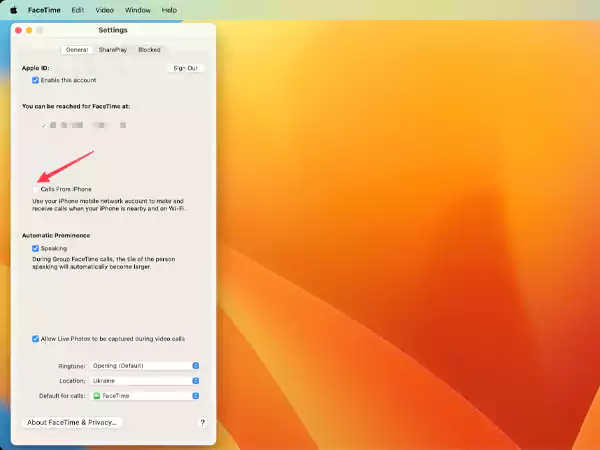
Also, you can configure your iPhone to stop transmitting the incoming calls to your Mac as follows:
- Visit phone’s Settings > Phone.
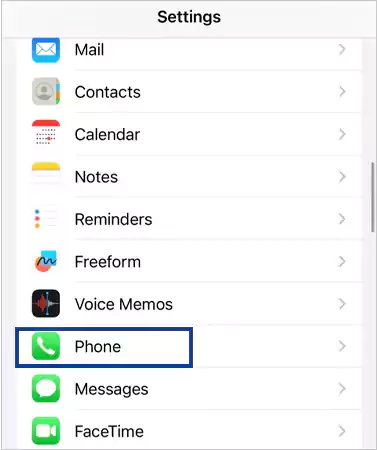
- Tap on Calls on Other Devices.
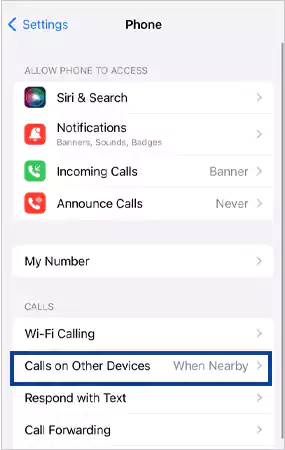
- Toggle off the Allow Calls on Other Devices option.
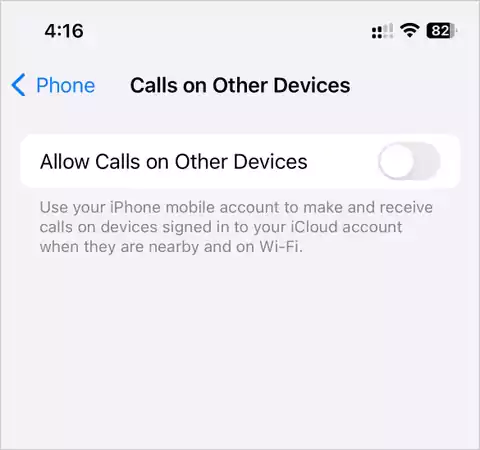
This way all incoming calls of iPhone will not disturb you while working on your Mac.
Turn Off the Continuity Camera
Continuity Camera feature lets your iPhone connect to your Mac and work as a webcam. When both devices are close to each other and are signed in with the same Apple ID, you can see the iPhone as the webcam in your Mac video conferencing app. However, it is possible to stop the integration of the continuity camera with the Mac as follows:
- Visit Settings on your iPhone > go to General.

- Tap on Airplay & Handoff.

- Then, toggle off the Continuity Camera.
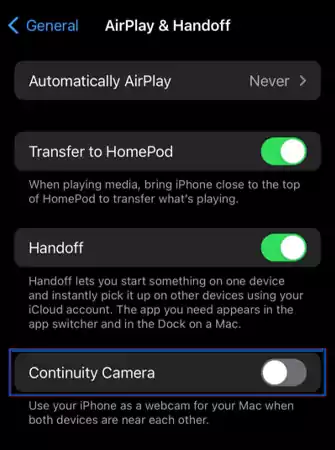
That was the process for how to disconnect the MacBook from the iPhone for the Continuity Camera feature.
Also Read: Top Mac Hard Drive Problems and Solutions
Stop Syncing of iPhone Notes With Your Mac
Notes and data from other built-in apps of iPhone by default synced to your Mac, signed in with the same Apple ID. If you want to stop this syncing you can follow these steps on your iPhone:
- Open Settings > Apple ID, iCloud, Media & Purchases.
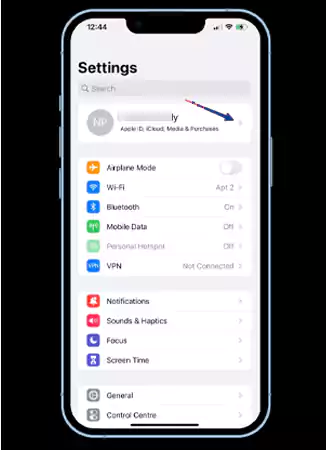
- Now, tap on iCloud.
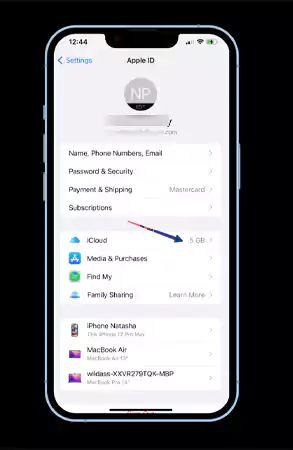
- Then, locate Notes and toggle off it.
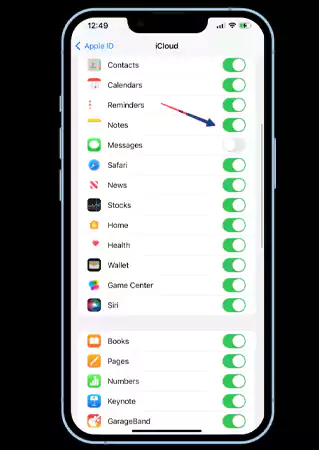
- Finally, a message will appear for the confirmation of your action. Tap on Delete from My iPhone there.
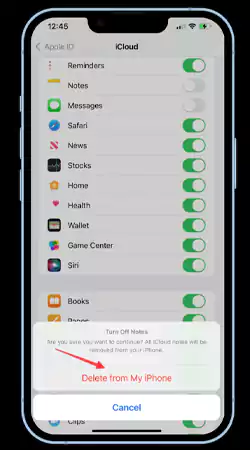
Similarly, you can locate any other app in Step 3 and toggle off the syncing.
To turn off syncing of Notes through your Mac, continue with these steps:
- Head to Apple menu > System Settings.

- Click on your Apple ID > iCloud.
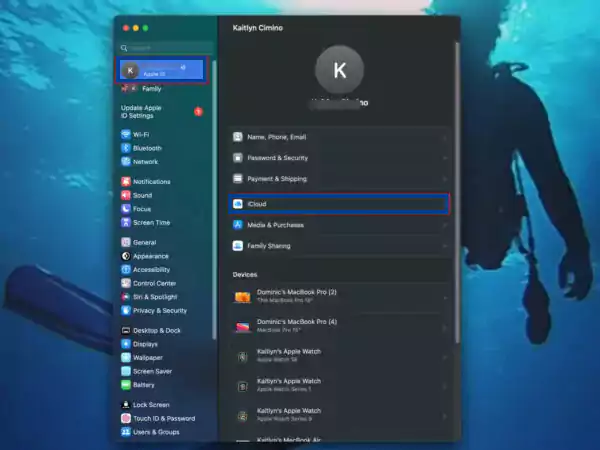
- Now, click on Show All under the Apps using iCloud.
- Then, select Notes and turn off Sync this Mac.
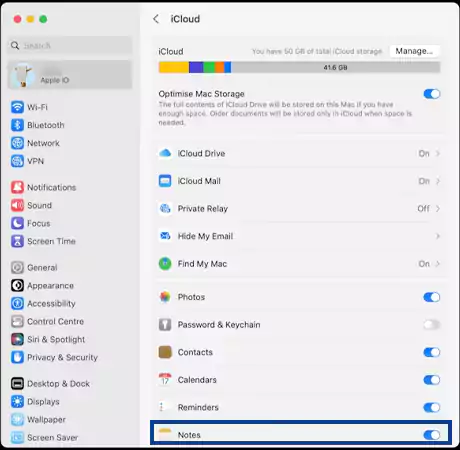
- Finally, click Done and quit System Settings.
Tips: If you don’t want to turn off syncing, you can create or move notes to the On My iPhone folder available in Notes on your phone. The notes stored there do not sync with iCloud and appear on your Mac.
Final Words
In this article, we got to learn how to disconnect iPhone from Mac in different ways. You can log out of the associated Apple ID to stop a complete syncing of devices or else can opt to disconnect for particular features such as Bluetooth, calls, Notes, AirDrop, Handoff, iCloud, and others.
So, follow the required procedure and enjoy separate working of your iOS and macOS.
Read Next: How to Update Safari on Mac, iPad, and iPhone in 2023? — [Explained]
FAQs
Ans: To disconnect the iPhone from the Mac, open Settings on iPhone > Apple ID > Find your Mac device > Remove from Account > Remove.
Ans: To erase a device in Find My on Mac:
- Open Find My > Devices.
- Select the required device > info button .
- Click Erase This Device.
- Enter a phone number > select Erase.
- Enter your Apple ID password > click Erase again.
Ans: To stop the automatic syncing of iPhones for all devices; open iTunes on Mac > select Edit > Preferences > Devices > Prevent iPods, iPhones, and iPads from syncing automatically.
Ans: To unpair Bluetooth on iPhones; go to Settings > Bluetooth > Info icon next to device name > Forget This Device > Forget Device.
Sources:
